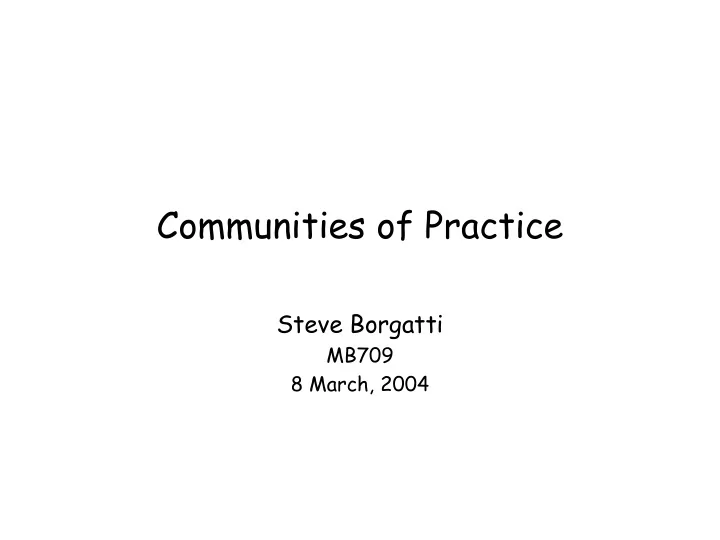

Communities of Practice Steve Borgatti MB709 8 March, 2004
Knowledge at the Center • Knowledge-based economy – Knowledge as key strategic asset • Resource-based (in fact, knowledge-based) view of the firm – In search of inimitable competitive advantage • How to create and exploit knowledge – Absorptive capacity
Technology Approach • Knowledge repositories – Creating common organizational memory • Skill profiles • Groupware Results have been disappointing
Technology Not Enough • Knowledge is often tacit • Knowledge is often situated in practice • Knowledge is often socially constructed
Tacit vs. Explicit Knowledge • Most knowledge is tacit – Not codified – Can’t be told directly • Knowing how vs. knowing that • Learning by managing opportunities – Apprenticeships • Also via stories – Xerox repairmen
Knowledge as Practice • Most knowledge is really knowing – Not abstract, discrete, set of independent facts or principles (“particle theory of knowledge”) – Embedded in behavior, routines, systems • Contextual • Part of practice • Learn by doing – Apprenticeships again
The Social Life of Information • Knowledge is mostly constructed and transmitted and held by interaction with others – Isolated genius is largely myth • Learning via watching, interacting, trying, getting corrected etc.; in short: participation – Apprenticeships again • Solving problems by – thinking aloud - explicitizing – Mutual aid – catching fire – Synthesizing solutions – like chromosomes recombining
Orr’s (1990) Study of Xerox Repairmen • Variance between formal description of work and informal ways it got done • Technicians spent a lot of time socializing, swapping repair stories, working on machines in pairs
Communities of practice • Lave & Wenger (1991) • Key characteristics – Narration – Social construction – Mutual engagement – Joint purpose – Shared repertoire – Legitimate participation • Works particularly well for functional groups in a single location – Claims processors • Organizations as collections of communities of practice
Mutual Engagement • Definition – amount and pattern of interaction among the members of the community. Through their interactions, they shape the group's culture and it's practices. – No work is fully specified. Mostly evolves, emerges • Three important aspects of mutual engagement are – enabling elements: social glue – diversity: complementarity and distributed cognition – multiplexity: joined by a variety of ties, including conflict • Key processes are narration and social construction – Story-telling, sense-making
Mutual engagement Structural Characteristics • Connectedness – Each member connected, directly or indirectly, to every other member. • Graph-theoretic distance (degrees of separation) – Relative to organizational networks in general, communities of practice have shorter graph-theoretic distances between all pairs of members. • Density (number of ties) – Relative to organizational networks in general, communities of practice have a greater density of ties. • Core/periphery – Communities of practice have core/periphery structures rather than clique structures. – Otherwise, they would be multiple communities of practice
Mutual engagement Individuals and the Group • Levels of participation – Full participation (insider) – Legitimate peripherality (newbie) – Marginality – Full non-participation (outsider) • Structural hypothesis – Coreness �� Participation • The greater an individual's participation in a community of practice, the greater his or her coreness score.
Joint Enterprise • The common purpose that binds the people together and provides a unifying goal and coherence for their actions • Three aspects – negotiated goals • group develops a conception of their joint goals through mutual engagement. • As a result, the joint enterprise may not be what management intends. – indigenous purpose • group itself creates its own identity, goals, enterprise • But some elements come from the larger structure in which they are embedded. – mutual accountability • regime of mutual accountability. People are responsible to each other for sharing information & making each other's lives easier. Self enforced • Because it is indigenous, and it is constructed by mutual negotiation, the joint enterprise is not like McDonald's mission statement which is tacked on the wall and completely ignored.
Shared Repertoire • Continual development and maintenance of shared repertoire of practice, procedures, techniques, shortcuts, jargon, tools, forms, symbols, mental categories, actions, concepts, etc. – Shared repertoire = culture – This is the most obvious outcome of a community of practice. • Three aspects – shared history. • Because the repertoire is built up and shaped over time by the participants themselves, they are part of their shared history and give a sense of identity and belongingness – richness. • The shared repertoire provides a language for communicating meaning. The larger the repertoire, the easier to express meanings because there is more to work with – ambiguity. • How elements of the repertoire are viewed and used is always up for interpretation. For example, chairs can be viewed as just what you sit on, or as symbols of how management views the claims processing unit. • Most central players should have most knowledge
Managing Communities • Can management decree a community of practice? • World Bank efforts • Detecting communities through network analysis – Searching for dense areas in the communication or collaboration network (clustering algorithms) – CoP have tell-tale core/periphery structure (c/p algorithm) • Core members have the most knowledge
Identifying communities via project collaboration data Management sci & technology apps Health & social projects Nodes colored by department 1000 scientists
Recommend
More recommend